Foreign Insulators
by Marilyn Albers
Reprinted from "Crown Jewels of the Wire", December 1998, page 4
NEW FINDS IN FOREIGN GLASS FROM THE
WILLIAMSBURG NATIONAL
The 1998 NIA Convention Show and Sale held in Williamsburg, VA the weekend of
July 31st - August 2nd provided an excellent hunting ground for collectors of
foreign glass and porcelain. On opening day of the show there were insulators to
be had from 26 different countries throughout the hall - that's a bunch! Let's
take a look at four examples that were of special interest.
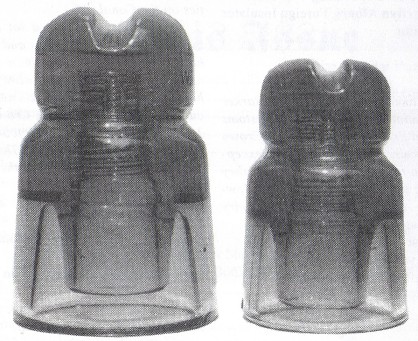
CD 579 from Poland finds a little brother with a new CD - 578.7
CD 579 has already been published and is shown at the left in the photo
above. It was manufactured in Poland and used on power lines in that country. This insulator is 5-1/2" tall and has a base diameter of
3-5/8". 'HUTA ROGOW' is embossed on one side of the crown and 'N.I.T-1-S'
appears on the opposite side. HUTA is the Polish word for factory. This is a
beautiful insulator in dark blue aqua glass.
Rick Baldwin, who was set up next
to our sales table at the show had brought a Polish glass insulator he wanted me
to see. As it turned out, it was the exact same style as CD 579 but shorter and
more slender, with a height of 4-5/8" and a base diameter of 2-7/8".
The color of this insulator was green aqua with many amber wisps throughout the
glass. Embossed on one side of the crown was a trademark that looked like this Ô
with the letters 'H.R.N.' on the opposite side. Unfortunately we haven't been
able to attribute these letters to either a manufacturer or a user. N.R.
Woodward (Woody) has classified this insulator as a CD 578.7, which is shown on
the right in the photo. Thanks for bringing it along Rick, your insulator was
really a super find and a perfect little brother for CD 579.
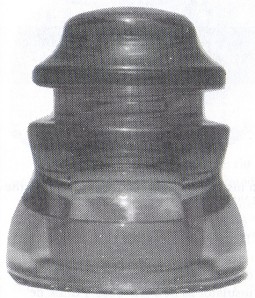
CD 155 found with 'E I V' embossing
Dale Huber of Colfax, California was at the National with several interesting
insulators he found in Chile. He asked me if I'd like to see them and of course
the answer was YES! There were several interesting styles of glass in the
lineup, plus an odd looking porcelain Grandma that I'll include in my next Crown
Jewels of the Wire article coming up in February of '99. But the most intriguing
insulator of all was a CD 155 in dark green aqua with round drip points, an
American threaded pin hole, and a French embossing! Kind of like finding a fish
with feathers. It looked brand new, like it came right out of the box. The
insulator is 4" in height and measures 3-1/2" across the base. On the front
skirt are the letters 'E I V' and on the opposite side is an embossed mold
number '18' right above 'U 15'. I couldn't wait to show this insulator to Woody!
He said that his E I V catalog (more complete than mine) does indeed show a
drawing of a CD 155, confirming that at the time of publication this particular style was one of
the company's current
products. He went on to say that the insulator was probably made in Brazil by a
company known as vFo or VIFOSA (Vidreria Industria Eiguerras
Oliveiras S.A.) for
use in Chile and other South American countries where round drip points and
American threaded pin holes are in common usage. This company was eventually
bought by EIV who continued to produce the 155 but preferred to identify the
insulator as one of its own products by using the French embossing. EIV stands
for Europeenne d'Isolateurs en Verre or European Insulators of Glass. E I V is
now part of the large corporation known as SEDIVER of France.
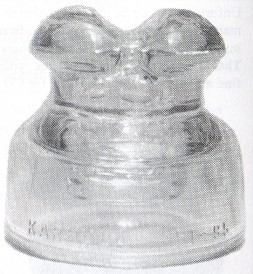
'KARHULA PL-95' from Finland
becomes new CD 608
In an article I wrote for the April '98 issue of Crown Jewels of the Wire I
was of the opinion that only one style of glass insulator, CD 453 from Finland,
had been found with the KARHULA embossing. Happily that is no longer true,
thanks to Eric Johnson of Stuart, Florida, who put on a fine display of Finnish
porcelain insulators at the National. Right in the center of his display was
this beauty in crystal clear glass with the embossing 'KARHULA PL-95' on the
front skirt. Eric allowed me to hand carry the insulator back to Houston so I
could make a shadow profile and record all the measurements needed for an
accurate scale drawing. It is 3-1/4" in height and 3-1/2"across the
base. After a good look at it, Woody classified the insulator as new CD 608. I
think he was just as excited as I was to see another style with the KARHULA
embossing.
Eric says that the KARHULA factory is located some 60 km. North of
Helsinki. He will try to learn more about this company to see if they are still
producing glass insulators. His friend Anne, whom several of you met at the
National, says that KARHULA means "Town of the Bears". What bears,
Eric? Keep us posted!
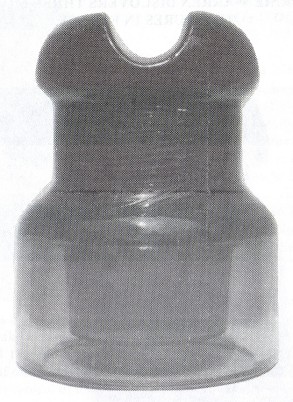
New CD 538 is assigned to 'FOLEMBRAY No. 235.'
This French jewel in dark emerald green is a real "hunker". It's
exactly two ounces short of four pounds! It is 5-3/4" in height and measures
4-3/8" across the base. That means it's tall, it's heavy, it's fat, and
it's one you wouldn't want to carry around too long before stopping to catch
your breath. They were definitely designed for use on high voltage power lines
and I give Jim Bergman credit for bringing back at least four of these from his
trip to France shortly before the '98 National. The name 'FOLEMBRAY' is
embossed on the front skirt and 'No 235' appears on the opposite side. The
Folembray company that produced these insulators is no longer known by that
name. It was purchased in 1952 by another French manufacturer called NORD-VERRE,
so the insulator is at least 46 years old - which is four years short of being
an authentic antique.
As a serious collector of foreign glass, I am constantly
amazed that there are still so many new styles waiting to be discovered.
Read
on. . . .
BERNIE WARREN DISCOVERS THREE MORE
TREASURES IN FRANCE
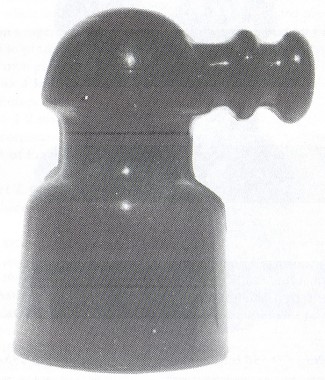
New CD 699.5 for 'ISOREX 254'
Bernie refers to this insulator as his 'Monster Noser'. What an incredible
find! Is he proud of it or what? It is a full 5-1/2" in height and has a base
diameter of 3-1/2". 'ISOREX' is embossed low on the front skirt and the
number '254' appears on the opposite side. There is an inner skirt, though it is not
visible through the dark olive green glass unless the insulator is held up to
the light. To date, I believe this is the largest glass 'noser' to be found.
Based on that assumption, Woody assigned the last available CD number in the 600
series to this gargantuan piece of glass - CD 699.5.
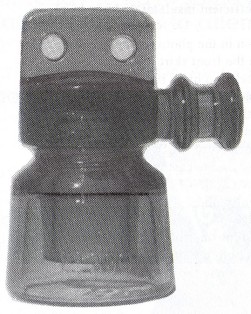
New CD 686.4 assigned
to 'FOLEMBRAY No 290'
During one of his recent trips to France, Bernie found this miniature one
armed 'robot' and it really captured his heart. It is the only example known at
this time and happens to be in perfect mint condition. Though it is similar to
CD 686.2 'FOLEMBRAY No 292', which was published in the June '97 issue of
Crown
Jewels of the Wire, CD 686.4 is enough shorter and narrower to warrant its own
CD number. It was a privilege just to borrow it long enough to make a shadow
profile and record measurements. The insulator is 4-1/2" in height and
measures 2-1/2" across the base. The glass color of this insulator is a
pretty yellow green which, with a few exceptions, is typical of most FOLEMBRAY
insulators.
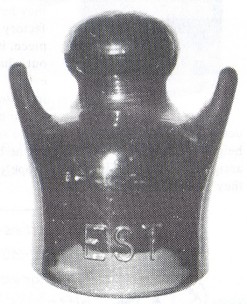
CD 640 with the rare 'EST' embossing
CD 640, the French insulator often described as a 'gingerbread boy' due to
its unique shape, has been fairly easy to find on sales tables just about any
time a show is held. Nearly every collector of foreign glass has at least one on
the shelf. During the years, several different companies in France have produced
this style, each factory adding its own trademark to the glass. Examples include
ISOREX, V.A., FOLEMBRAY, L'ELECTRO VERRE, SAV, CL, YERRERIES DE REIMS, EIY,
etc. Obviously, the 640 has been an efficient insulator and was used widely on
French lines.
The particular example shown in the photo on the previous page has
the 'ISOREX' embossing on the front skirt with the numbers '35/3' on the
opposite side. It is 4" tall and has a base diameter of 2-1/2".
Nothing unusual there. But the added letters EST change the picture
considerably! Many CD 642 's, the larger gingerbread insulators, have the 'EST'
embossing,
but until just a short time ago, we had not seen it on a 640. EST is the French
word for East, and it indicated that the insulators were to be used on the east
branch of the French National Railway Company known as SNCF, or Societe
Nationale de Chemin de fer Francais. Apparently, there were more 642's than
640's in service along the railway.
While in France, Bernie Warren was able to
find a small number of 640's in dark olive green with both the 'ISOREX' and
'EST' embossing. Two examples were seen at the Williamsburg National and quickly
found homes.
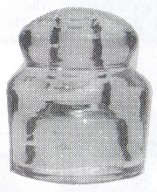
Unembossed Finnish insulator
is classified as new CD 438
Just a short time ago, Eric Johnson received another glass insulator from his
friend in Finland. He thinks it may have come from the KARHULA factory but with
no embossing on the piece, it is nearly impossible to find out what company
produced it, or even if it is of Finnish origin. The insulator is made of light
blue glass and appears to be a fairly new product, probably designed for use on
the side of a building. It is 2-1/4" in height and measures 1-7/8"
across the base. New CD 438 has been assigned to this little insulator.
Hope you find more of these Eric - they're precious!
| 